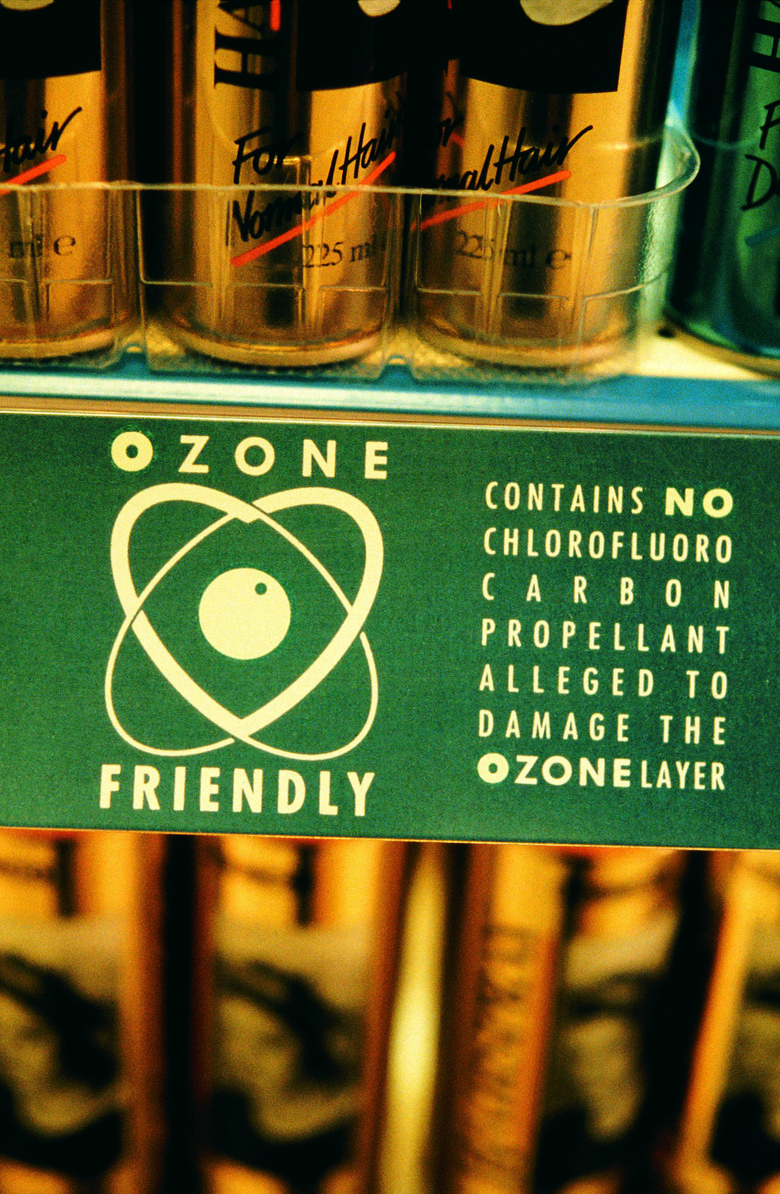How Do CFCs Break Down The Ozone Layer?
Chlorofluorocarbons, or CFCs, are a class of gases once widely used as refrigerants and propellants. Although they are both nontoxic and very useful, CFCs damage the ozone layer, the thin layer of Earth's upper atmosphere that absorbs UV light from the sun. Because UV light can cause skin cancer in humans, damage to the ozone layer has serious possible consequences for your health.
CFCs
CFCs
CFCs are fairly nonreactive. This same feature makes them both attractive as industrial chemicals and dangerous to the environment. Because they are so nonreactive, they break down very slowly when released into the atmosphere, giving them time to reach the layer of Earth's atmosphere called the stratosphere. Several miles above Earth's surface in the stratosphere lies a layer rich in a gas called ozone. Each molecule of ozone is made from three oxygen atoms, which is unlike ordinary molecules of oxygen gas that contain only two oxygen atoms apiece.
Chlorine
Chlorine
When they are exposed to strong ultraviolet light, CFCs finally break down to release lone chlorine atoms with an unpaired electron. These chlorine atoms are highly unstable and react with ozone to break it down into oxygen through a type of chain reaction. A single chlorine atom can react with as many as 100,000 molecules of ozone before it finally combines with another atom to form a stable compound. That's why even small numbers of CFC molecules can destroy large quantities of ozone and remain active in the upper atmosphere for long periods of time.
Volcanic Activity
Volcanic Activity
Although CFCs are a product of human activity, volcanoes can contribute to the damage by making these ozone-destroying agents even more devastating. Small dust particles scattered by eruptions such as 1992 eruption of Mt. Pinatubo in the Philippines reach the upper atmosphere and interfere with chemical reactions that remove the chlorine atoms. When this happens, the chlorine atoms remain active for a longer period of time and thus have a chance to break down many more ozone molecules.
Ozone Replenishment
Ozone Replenishment
CFCs don't remain active indefinitely, of course; over time, chemical reactions convert the chlorine atoms into other more stable compounds that don't break down ozone. That's why CFC levels in the stratosphere will gradually fall as long as humans cease to add these gases to the atmosphere. Given enough time with no CFCs present, the ozone layer can eventually recover from the damage, because ozone is formed in the upper atmosphere through natural chemical processes. Production of CFCs was phased out by the mid-1990s through an international agreement called the Montreal Protocol. According to the U.S. Environmental Protection Agency, scientists believe that the ozone layer may return to normal levels sometime after 2060.
References
- Organic Chemistry Structure and Function, 6th Edition; Peter Vollhardt and Neil Schore
- United States Environmental Protection Agency: Ozone Science, The Facts Behind the Phaseout
Cite This Article
MLA
Brennan, John. "How Do CFCs Break Down The Ozone Layer?" sciencing.com, https://www.sciencing.com/cfcs-break-down-ozone-layer-3572/. 24 April 2017.
APA
Brennan, John. (2017, April 24). How Do CFCs Break Down The Ozone Layer?. sciencing.com. Retrieved from https://www.sciencing.com/cfcs-break-down-ozone-layer-3572/
Chicago
Brennan, John. How Do CFCs Break Down The Ozone Layer? last modified March 24, 2022. https://www.sciencing.com/cfcs-break-down-ozone-layer-3572/
